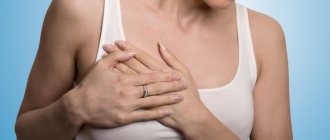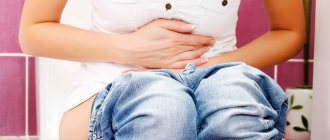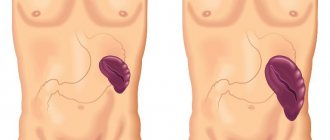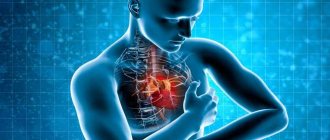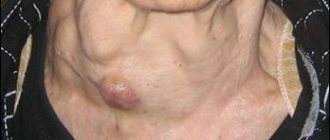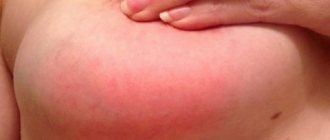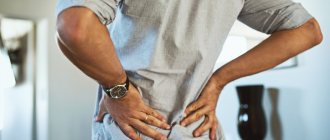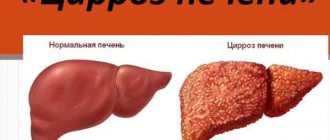Breast pain is one of the common reasons why women seek help from a specialist.
This problem does not always need to be treated by a gynecologist or mammologist; in some cases, the help of other specialists is required. In addition, complications associated with pathologies not treated in time can be severe, sometimes even life-threatening.
Types of breast pain
Chest pain is divided into:
According to the nature of the pain syndrome
- aching or aching-pulling;
- dull;
- piercing;
- pulsating;
- cutting;
- burning;
- shooting.
By localization
- double-sided;
- one-sided;
- in the upper quarters of the gland;
- in the lower quarters;
- total encircling.
By intensity
- acute strong;
- medium intensity;
- discomfort or severe discomfort in the mammary gland.
Depending on the period of occurrence
- cyclical pain (mastodynia) – pain syndrome is associated with the menstrual cycle or hormonal imbalance;
- acyclic mastalgia - chest pain is associated with the presence of pathological processes in the gland or nearby organs and occurs regardless of the woman’s monthly cycle.
Distinctive features of periodic or cyclical chest pain are:
- discomfort or pain in the mammary gland occurs at a certain period of the menstrual cycle (usually in the second half, after ovulation or a week before the onset of menstruation, less often a few days before the onset of menstruation and during menstruation);
- the pain is characterized as aching or dull and is localized in the upper quarters of the mammary glands or throughout the entire gland (total girdle) and radiates to the armpits;
- pain always occurs in both mammary glands;
- the breasts swell and increase in size, sometimes multiple nodules appear, disappearing in the first phase of the cycle (after menstruation);
- Mastodynia is often accompanied by irritability, headaches, nagging pain in the lower abdomen, psycho-emotional instability;
- Cyclic pain is more common in women of childbearing age, adolescence, or premenopause.
Non-cyclic pain in the mammary gland is different:
- lack of connection with the menstrual cycle;
- varying intensity and nature of pain (usually in the form of burning, squeezing or bursting) and localization in a specific area of the mammary gland;
- in most cases one breast is affected;
In addition to pain, other symptoms and signs are observed:
- deformations of the mammary gland and nipple;
- areas of inflammation or mass formations in the chest;
- changes in the skin and its structure, the presence of pathological discharge from the nipple;
- there is an increase in regional lymph nodes;
- there is general weakness, lethargy, fever, nausea, loss of appetite;
- pain is more common in women over 30 years of age or after menopause.
How to relieve pain symptoms
Severe chest pain can be relieved in various traditional ways. For example, a cabbage leaf that is pre-coated with honey and applied to the chest at night turns out to be effective. This natural compress can quickly eliminate severe pain.
Decoctions of herbs with anti-inflammatory and analgesic effects are also helpful. These include chamomile, coltsfoot, calendula, linden, and yarrow. When using traditional medicine, you must be careful, as many herbs can cause allergic reactions. In addition, you should not resort to herbal treatment when you are not sure that there is no pregnancy. This is due to the fact that some compounds can cause involuntary abortion.
It is recommended to review your diet. It is necessary to remove hot and spicy dishes from it, and to enrich the menu with fruits, vegetables and herbs.
Why do the mammary glands hurt?
Mastodynia or cyclic mastalgia occurs as a result of the influence of female sex hormones on a woman’s body. The release of hormones by the endocrine glands and organs of the reproductive system (estrogens, progesterone and prolactin) in a certain phase of the cycle (usually after ovulation) provokes an increase in the chemical activity of prelactation compounds and the proliferation of epithelial cells of the mammary gland. This causes an increase in the size of the gland ducts, hypertrophy of the lining cells and fluid retention in the tissues of the mammary glands. In this case, there is an increase in breast size, swelling and irritation of the nerve endings in the glandular tissue. In this case, persistent discomfort and pain are noted in the second (luteal) phase of the menstrual cycle. After the start of menstruation, the pain decreases significantly and disappears completely.
The causes of cyclic mastalgia are
- functional changes in hormonal levels in different phases of the menstrual cycle (pain in the mammary gland before menstruation);
- temporary dishormonal changes in a woman’s body (mastopathy);
- gynecological diseases (polyps, endometriosis, ovarian cysts), causing changes in the release of female sex hormones;
- menopause (changes in the production of sex hormones and the sensitivity of mammary gland cells to them);
- long-term use of oral contraceptives or infertility treatment;
- use of antidepressants;
- stress, psycho-emotional overstrain, neurosis, chronic fatigue syndrome can increase the manifestation of PMS and changes in the production of sex hormones;
- imbalance of fatty acids in breast tissue and local increase in the sensitivity of gland cells to female sex hormones (with metabolic disorders, obesity or rapid weight loss).
Non-cyclic mastalgia occurs as a result of non-hormonal changes occurring in the mammary gland:
- inflammation;
- stagnation of milk;
- sclerosis of glandular tissue;
- the appearance of benign and malignant neoplasms;
- injuries;
- surgical interventions;
- malformations of the ducts and milky lobules;
- wearing tight underwear;
- large breast sizes.
These are anatomical changes in tissues that provoke vascular spasm, compression of nerves, the appearance of inflammatory infiltrates, tissue proliferation with the formation of conglomerates and cysts, hematomas, adhesions, and overstretching of the ducts. All these changes cause pain in the mammary gland.
Causes of pain
The causes of pain in the mammary gland are different, so it is necessary to know their distinctive signs for various functional changes, pathological processes or diseases. Pain in the mammary gland before menstruation is caused by physiological changes in hormonal levels and an increase in the production of active substances (mediators) in the glandular tissue.
Discomfort or nagging, dull and/or bursting pain during PMS appears in both mammary glands 7-10 before the onset of menstruation and decreases after its onset with a gradual disappearance in the first phase of the cycle. With stress, neuroses, fatigue, physical or psycho-emotional stress, the symptoms of mastodynia intensify. There are changes in the woman's general well-being and behavior - lethargy, headaches, irritability and imbalance.
Typically, pain and other symptoms of premenstrual syndrome go away on their own and do not require treatment. But if persistent pain appears with increasing intensity, breast swelling for more than 2 weeks, no reduction in these symptoms after menstruation, menstrual irregularities and other pathological signs, you should consult a specialist. The causes of mastalgia can be gynecological diseases, neuroendocrine pathology, mastopathy, long-term use of contraceptives or antidepressants. All these conditions require medication correction, physiotherapeutic procedures, homeopathic medicines, and herbal medicine.
Probable diseases
Diseases that can cause breast pain include:
- mastitis and abscess - an inflammatory or purulent-inflammatory process in the chest;
- benign breast tumors (fibroadenoma, lipoma, cysts);
- malignant tumors (cancer, lymphosarcoma, Paget's cancer);
- breast injuries with the formation of hematomas, tissue ruptures, ducts and milk lobules);
- postoperative complications (inflammation or compression of nerves due to implant failure,
- postoperative scars);
- sclerotic changes in the mammary gland (sclerosing adenosis, reactive sclerosis of connective tissue);
- intercostal neuralgia;
- osteochondrosis;
- inflammatory diseases of the chest organs;
- myositis;
Pain in a nursing mother
Quite often, pain in the mammary glands occurs in nursing mothers:
- with lactostasis;
- with lactation mastitis;
- with lactation abscess;
- with lactocele.
The most common cause of pain in the mammary gland in nursing women is lactostasis (milk stagnation).
Both of these pathologies develop in the first month after birth and are associated with an unsteady feeding rhythm or disturbances in feeding technique.
Lactostasis occurs with increased milk production, sluggish sucking, infrequent breastfeeding, large mammary glands, and improper feeding technique.
All these factors lead to stagnation of breast milk in the milk lobules and ducts, their overfilling and overstretching, the formation of painful areas in one or two glands.
Lactostasis manifests itself
- pain in a certain area of the mammary gland;
- compaction, slight redness and increased local temperature;
- light massage and expressing milk are painful, but bring significant relief;
- weakness and an increase in body temperature to subfebrile levels are noted.
Lack of treatment and elimination of the causes of this pathological process can lead to the development of lactation mastitis and its complication - mammary abscess.
Lactation mastitis
Lactation mastitis is an inflammatory process of the milk lobule or lobules, caused by prolonged stagnation of milk and the entry of pathogenic and conditionally pathogenic microflora into the ducts and lobules, causing the development of inflammation.
Mastitis is manifested by the occurrence of persistent acute pain in a certain area of the chest with irradiation of pain to other areas or to the armpit, skin hyperemia, swelling and a significant increase in local temperature, weakness, lethargy, headaches and an increase in body temperature to febrile levels. Expressing milk is extremely painful and does not bring relief.
If these symptoms appear in a nursing mother, you should immediately contact a specialist (gynecologist or surgeon) to prescribe treatment.
If a nursing mother with signs of lactation mastitis does not go to a medical facility in a timely manner, the disease becomes complicated and an abscess (a cavity filled with pus) forms at the site of the inflammatory focus.
Symptoms of transformation of mastitis into an abscess include:
- acute local pain in a specific place of the gland, bluish tint of the skin and identification of the area of fluctuation (softening);
- persistent increase in temperature to 39.5 - 40 degrees;
- a pronounced change in general health - weakness, headache, lack of appetite, dizziness, fatigue and drowsiness.
Treatment of an abscess is only surgical - opening the abscess and draining it, introducing disinfectants and antibacterial drugs into the cavity.
Lactocele
Lactocele is a special type of lactostasis that occurs in a nursing woman after an injury, against the background of a congenital anomaly of the ducts or milk lobules, scar changes after surgery or inflammation. All these factors interfere with normal lactation, so a cyst filled with breast milk forms in a certain area of the gland. Gradually, as the milk arrives, the cyst increases in volume, causing a feeling of fullness and persistent discomfort. On palpation, it is determined as a soft, mobile formation that does not decrease with expression.
If similar symptoms appear, especially in the presence of predisposing and provoking factors (trauma, surgery, congenital anomaly), you should contact a surgeon. The diagnosis can be clarified by puncture of the cyst followed by its removal.
Presence of discomfort during pregnancy and lactation
If it shoots in the nipple and breast with the onset of pregnancy, this is explained by sharp hormonal fluctuations that are characteristic of the first trimester. At this time, there is an excess of progesterone.
The excessive presence of this hormone after conception is not an accident. Progesterone performs important functions:
- Promotes successful pregnancy.
- Prepares the breast for the lactation process.
The process of formation of new nerve endings does not keep up with the rapid expansion of the milk ducts, so the expectant mother may be bothered by lumbago in the chest.
If there is a shooting in the chest during breastfeeding, and the pain is acute, this is most likely the manifestation of the body’s individual reaction to the lactation process. It is especially common in women who have given birth to their first child.
On the other hand, an anomaly in nursing mothers may be a consequence of:
- Incorrect attachment of the baby to the breast.
- Incorrect latching of the nipple by the child.
- Non-standard nipple shape.
- Formation of cracks in the nipples.
- Stagnation of milk (lactostasis).
- Development of mastitis.
- Insufficient hygiene of the mammary glands after feeding, which leads to the formation of cracks in the nipples, due to which the breasts begin to shoot.
Pain due to breast mastopathy
Mastopathy is a collective concept in gynecology, including all pathological processes in the mammary glands, which are characterized by the presence of:
- lumps and/or mass formations in the breast;
- pain in the mammary gland;
- pathological discharge from the nipple.
The most common is diffuse fibrocystic mastopathy. In most cases, this is not considered a disease, but a special condition of the female breast that occurs against the background of temporary or permanent dyshormonal changes in the woman’s body (excess of estrogen and prolactin). Mastopathy is characterized by a uniform proliferation of glandular and/or fibrous tissue.
Pain in the mammary gland manifests itself in the form of nagging pain in the upper outer parts of the glands, the process is often bilateral and is directly related to the menstrual cycle (increased pain in the second phase of the cycle and decreases after menstruation). Also noted are engorgement and swelling of the mammary glands, multiple nodular elements, and less often, clear, straw-colored discharge from the nipple.
Localization of pain
Let's consider options where discomfort may be localized
Breast
In the case of mastopathy, burning and pain can be felt anywhere in the mammary gland, both due to the proliferation of connective tissue and due to injury. The pain can be throbbing, aching, or burning like fire. The symptom can appear on both the right and left sides.
With fibroadenoma, the burning sensation is usually localized in the upper part of the breast.
A burning sensation in the left chest is a possible sign of angina. It is accompanied by a feeling of chest compression. The pain gets worse when walking or getting excited. If, in addition to a burning sensation on the left side, the patient experiences general pallor and sweating, this may indicate a myocardial infarction. In this case, you need to urgently call a doctor.
Nipple
A burning nipple is a mandatory reason to make an appointment with a doctor. In most cases, it is explained by normal physiological changes in the female body, associated, for example, with pregnancy, lactation or menstruation.
A common cause is the formation of a crack during breastfeeding. A burning nipple can also be caused, for example, by a tight bra or swimsuit. But at the same time, this may be one of the symptoms of mastitis, adenoma. In addition, a burning sensation in the nipple, along with some other signs, may indicate nipple cancer.
Breast cyst pain
Cysts are pathological cavities in the glandular tissue of the mammary gland filled with fluid. Almost every woman has one or more small cysts. These formations occur normally during the menstrual cycle. Only large cysts that cause discomfort or pain are considered pathological.
Typically, the cause of cysts is dyshormonal disorders and after a thorough examination (ultrasound, puncture, histological examination of a biopsy specimen and cytological analysis of nipple discharge), provided there are no atypical cells and the threat of cancer, small cysts are not removed.
Preventive measures
If diseases accompanied by pain in the mammary glands have not been identified, then by normalizing your daily routine and diet, as well as giving up bad habits, many unpleasant consequences can be prevented.
The following recommendations must be followed:
- Avoid drinking alcoholic beverages.
- Quit smoking.
- Beware of hypothermia.
- Visit your local physician and gynecologist regularly.
- Treat diseases and prevent them from becoming chronic.
- If possible, avoid stressful situations and emotional stress.
- Stick to proper nutrition, providing your body with all the necessary vitamins and elements: include fruits and fresh vegetables, lean meat, and fish in your menu.
- Take courses of vitamin therapy, especially in the autumn and spring.
- Select underwear by size, purchase comfortable and easy-to-wear models made from natural fabrics.
- Before the onset of menstruation and during menstruation, avoid drinking strong tea and coffee, carbonated drinks and chocolate.
Pain from breast fibroadenoma
Fibroadenoma is a benign tumor of the breast. This pathological process in breast tissue in most cases is a round, painless tumor that arises as a result of the proliferation of glandular and connective tissue of the mammary gland.
For a long time, the disease can be asymptomatic and can be detected during routine examinations, ultrasound examination or radiography. Mastalgia occurs when the tumor is large, actively growing, or has a certain localization of the tumor.
The main cause of fibroadenomas is persistent hormonal fluctuations in young women of childbearing age.
These tumors, under the influence of unfavorable factors, can transform into cancer, so when they are detected, a biopsy is required (sampling cells from the tumor and studying them under a microscope). Due to the high risk of transformation of fibroadenoma into a malignant neoplasm, this pathological process (unlike cysts and mastopathy) must be removed.
Breast examination if pain occurs
Mammography is an x-ray examination of the mammary glands. The method is the standard for diagnosing breast pathology in women over 40 years of age. It allows you to assess the condition of the mammary gland tissue, the prevalence of pathology, and the nature of the growth of the tumor process. But if the glandular dense component predominates in the breast, mammography becomes uninformative. Therefore, young women are recommended to have an ultrasound instead of an x-ray.
Ultrasound of the mammary glands - ultrasound examination of the breast is indicated in the following cases:
- in pregnant and lactating women
- in young women for the purpose of prevention
- in all women with complaints of pain (as an addition to mammography)
- for differential diagnosis of cysts
CT and MRI of the mammary glands - computed tomography and magnetic resonance imaging - additional examination methods. There is no need to use them when you first consult a doctor or generally for prophylaxis. Usually they are resorted to when the diagnosis is unclear, when mammography and ultrasound give an unclear picture. In addition, MRI and CT help to assess the condition of neighboring organs and detect even distant metastases in malignant tumors.
Aspiration biopsy - for painful (or painless) formation in the mammary gland, especially in menopausal women and with a family history, one x-ray is not enough. To make a diagnosis, you need to study the cells of the formation for malignancy. For this purpose, aspiration biopsy is often used. In some cases, this stage is skipped, resorting immediately to removal of the tumor and subsequent examination of the resulting material.
If necessary, the doctor prescribes additional examination methods to make a diagnosis.
What to do if there is pain in the mammary gland
If you are concerned about pain in the mammary gland, you should consult a specialist.
When to see a gynecologist or mammologist:
- pain appears every day for two weeks, there is an increase in its intensity and a change in the nature of mastalgia;
- the pain syndrome is localized in a certain area of the mammary gland, radiates to the axillary region and interferes with everyday life;
- a mass formation, an area of inflammation, cords are palpated in the chest);
- the appearance of other symptoms is noted (fever, lethargy, redness of the skin, discharge from the nipple, asymmetry of the mammary gland).
If the pain in the mammary gland is severe (acute)
If severe (acute) pain appears in the chest, you must immediately contact a medical facility to clarify the diagnosis and prescribe timely treatment.
Questions your doctor may ask
Before visiting a doctor, you need to think about some questions that the specialist will probably ask.
- In what part of the chest does the pain feel?
- What is the nature of the sensations? (aching, bursting, stabbing pain?)
- How long does the pain last?
- Rate the severity of pain on a 10-point scale
- Does one or both mammary glands hurt?
- Is there a pattern when pain occurs (menstruation, physical activity, breastfeeding, etc.)
- When did you have your last mammogram?
- Are there other symptoms? (breast lumps, nipple discharge, etc.)
- You are pregnant? Are you breastfeeding? Have you recently had a medical abortion or miscarriage?
- Have you had a history of breast trauma or breast surgery?
- Has anyone in your immediate family had breast, ovarian or colon cancer?
Author:
Evtushenko Anna Aleksandrovna obstetrician-gynecologist
Diagnostics
The main methods for determining the cause or clarifying the diagnosis when mastalgia occurs are:
- interview, history taking and palpation of the mammary glands;
- Ultrasound of the breast and axillary lymph nodes;
- consultations with specialists (gynecologist, endocrinologist, surgeon, neurologist, therapist);
- laboratory research;
- mammography, ductography;
- biopsy;
- thermography;
- pneumocystography.
Causes of pain
The reasons can be very different:
- Individual features of anatomy. Pain can be caused by injuries, cysts, or surgical interventions.
- Taking certain groups of medications, usually hormonal. This also includes oral contraceptives.
- Breast size. Some girls with a large size often have shooting pains in the chest, which is caused by increased stress on the muscles and ligaments.
- Acid imbalance. A lack of fatty acids leads to increased breast sensitivity.
And of course, if your chest shoots, you can suspect some diseases of the mammary glands.
Treatment of breast pain
Treatment for breast pain depends on the source and cause of the pain. Therefore, treatment is prescribed only after the diagnosis has been clarified or the presence of a pathological process has been excluded.
If there are functional disorders in the mammary gland associated with temporary dishormonal changes, a mild correction of the malfunction is prescribed:
- phytotherapy;
- vitamin and mineral complexes;
- anti-stress and sedative medications;
- enzymes (for metabolic disorders);
- mild immunostimulating drugs;
- medications to normalize the synthesis of sex hormones.
An important point is to exclude coffee, alcohol, chocolate, Coca-Cola, and products containing preservatives and taste stabilizers from the diet.
Less commonly, oral contraceptives and antiprolactin drugs are used to normalize hormonal levels.
The main methods of treating mastopathy are:
- normalization of hormonal levels;
- physiotherapeutic procedures;
- phytotherapy;
- Spa treatment.
When cysts are diagnosed, drug correction of hormonal levels and treatment of pathological changes that cause endocrine disruptions are prescribed.
If cystic formations cause severe pain: an inflammatory infiltrate is determined, they are large or actively growing, changes are noted during cytological and histological examination - they must be removed.
For mastalgia not associated with breast diseases, treatment is carried out for the underlying disease that caused the appearance of this symptom (intercostal neuralgia, herpes zoster, osteochondrosis, myositis).
Surgical intervention is used for fibroadenoma, malignant neoplasms, abscesses, the presence of lactocele, postoperative complications and injuries.
Treatment
All breast diseases that can cause pain and serious consequences are treated differently. It is usually customary to distinguish two main methods: drug therapy and surgical treatment.
Drug therapy
Medication methods are currently given great importance and this is due to the fact that surgical treatment does not always give the desired effect, in addition, there may be contraindications and unavailability of this method of treatment.
There are several areas of drug therapy depending on the type of pathological process that caused the pain:
- Anti-inflammatory drugs. Prescribed at the initial stages of inflammatory diseases, as well as in combination with other treatment methods. They can not only relieve swelling and poor circulation, but also relieve pain.
- Antibacterial agents. Used in case of bacterial damage to the gland. The most common indications are abscess, suppuration, mastitis, as well as the addition of bacterial inflammation in a malignant lesion. Antibiotics are also prescribed for increased body temperature and signs of severe intoxication.
- Hormonal drugs. They are widely used for dishormonal diseases, such as mastopathy, cysts, fibroids, etc. In the case of cyclic pain, they can reduce fluctuations in hormone levels, as well as reduce sensitivity to them. In addition, in case of large benign formations, they can slow down the increase in size and, in some cases, even reduce them.
- Herbal preparations are also widely used. They help fight both cyclic pain and other forms of mastalgia, in which hormonal therapy is contraindicated.
Surgical intervention
Surgical treatment is also common, but in some cases it is the only acceptable one:
- Usually these are inflammatory processes in the suppuration stage, especially such as abscesses , boils, etc. In this case, it is necessary that a purulent focus forms and its removal proceeds without problems.
- In some cases, it may be necessary to install drainages , which will ensure the best outflow of contents and will prevent the occurrence of edema and stasis of lymph or blood.
- Cysts, fibroids and other benign formations are also subject to removal. Although the risk of their degeneration into a malignant neoplasm is quite low, there is still a certain percentage; in addition, depending on the hormonal background, their growth and the further appearance of associated complications may occur.
Surgical removal is one of the mandatory conditions for the treatment of cancer. In this case, it can be partial, when the tumor itself and the tissue adjacent to it are removed. This is also a total removal of the mammary gland, which very often requires excision of lymph nodes, usually a group of axillary ones.
If complications develop during plastic surgery on the mammary glands, in some cases repeated intervention is required, especially if the formation of infiltrate and suppuration occurs, as well as implant rejection.
Prevention
Preventive measures for mastalgia:
- Caring for women's health and preventing dyshormonal disorders:
- avoid stress, anxiety, physical and nervous strain;
- have sex regularly;
- balanced diet;
- physical activity;
- systematic strengthening of the immune system;
- absence of abortions;
- refusal to wear tight underwear.
Treat all gynecological diseases in a timely manner, correct metabolic and endocrine disruptions. Undergo an annual preventive examination with a gynecologist and mammologist.
